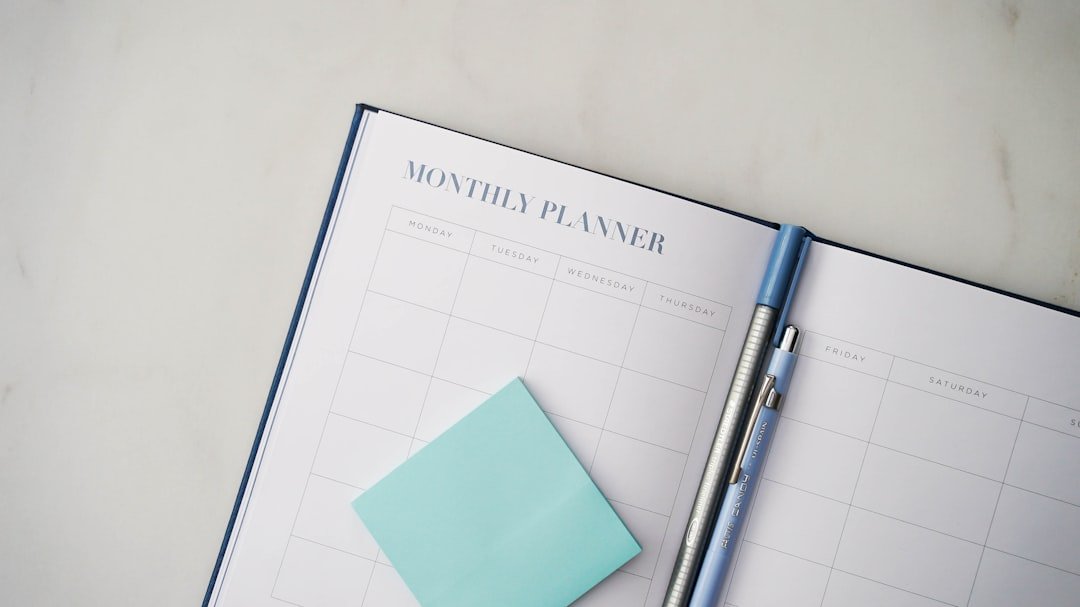Attention Deficit Hyperactivity Disorder (ADHD) is a neurodevelopmental condition that affects millions of individuals worldwide. If you have ADHD, you may find it challenging to maintain focus, manage time effectively, and organize tasks. These difficulties can lead to feelings of frustration and overwhelm, especially when it comes to planning your week.
Understanding how ADHD impacts your ability to plan is the first step toward creating a system that works for you. The symptoms of ADHD can manifest in various ways, including impulsivity, inattention, and hyperactivity, which can complicate your ability to stick to a structured schedule. Weekly planning can serve as a powerful tool for managing the symptoms of ADHD.
By breaking down your tasks into manageable segments, you can create a clearer picture of what needs to be accomplished. This approach not only helps you stay organized but also allows you to visualize your week ahead, making it easier to allocate time for both responsibilities and leisure activities. When you understand how ADHD affects your planning abilities, you can tailor your weekly planner to suit your unique needs, ultimately leading to a more productive and fulfilling week.
Key Takeaways
- Understanding ADHD and Weekly Planning:
- ADHD can make it challenging to stay organized and manage time effectively.
- Weekly planning can help individuals with ADHD break down tasks and manage their time more efficiently.
- The Benefits of Using a Weekly Planner for ADHD:
- A weekly planner can provide structure and routine, which can be beneficial for individuals with ADHD.
- It can help reduce feelings of overwhelm and anxiety by breaking tasks into manageable chunks.
- How to Use the Free ADHD Weekly Planner Template:
- The template provides a visual way to organize tasks and prioritize activities.
- It includes sections for important reminders, appointments, and self-care activities.
- Strategies for Effective Time Management with ADHD:
- Breaking tasks into smaller, more manageable steps can help individuals with ADHD stay on track.
- Setting specific time limits for tasks and using timers can help improve focus and productivity.
- Tips for Prioritizing Tasks and Goals:
- Using color-coding or symbols can help prioritize tasks based on urgency and importance.
- Breaking down larger goals into smaller, achievable steps can make them more manageable for individuals with ADHD.
- Incorporating Self-Care and Breaks into Your Weekly Plan:
- Scheduling regular breaks and self-care activities can help prevent burnout and improve overall well-being.
- It’s important to prioritize self-care and relaxation to maintain a healthy work-life balance.
- Overcoming Procrastination and Distractions with ADHD:
- Setting specific, achievable goals and deadlines can help combat procrastination.
- Minimizing distractions by creating a designated workspace and using tools like noise-cancelling headphones can improve focus.
- Adjusting and Adapting Your Weekly Plan as Needed:
- Flexibility is key for individuals with ADHD, so it’s important to be open to adjusting the weekly plan as needed.
- Reflecting on what worked and what didn’t each week can help refine the planning process for better results.
The Benefits of Using a Weekly Planner for ADHD
Creating Structure and Reducing Anxiety
One of the most significant advantages of a weekly planner is its ability to create structure in your life. By mapping out your week visually, you can reduce anxiety and uncertainty about what lies ahead. This clear outline of your tasks and commitments enables you to focus on one thing at a time, rather than feeling overwhelmed by everything that needs to be done.
Encouraging Accountability and Follow-Through
Another benefit of a weekly planner is that it encourages accountability. When you write down your tasks and goals, you are more likely to follow through with them. This sense of accountability can be particularly helpful for those with ADHD, as it provides a tangible reminder of what you need to accomplish.
Tracking Progress and Identifying Patterns
Planners often include space for notes and reflections, allowing you to track your progress and make adjustments as needed. This ongoing evaluation can help you identify patterns in your behavior and develop strategies for improvement. By regularly reflecting on your progress, you can refine your approach and make meaningful changes to your daily routine.
How to Use the Free ADHD Weekly Planner Template

To get started with using a free ADHD weekly planner template, first, find one that resonates with you. There are many templates available online that cater specifically to individuals with ADHD, featuring sections for daily tasks, appointments, and even self-care activities. Once you’ve chosen a template, print it out or save it digitally so that you can access it easily throughout the week.
When filling out your planner, begin by listing all the tasks and commitments you have for the week ahead. This could include work responsibilities, personal errands, appointments, and social engagements. Be sure to break larger tasks into smaller, more manageable steps.
For example, instead of writing “complete project,” you might list “research topic,” “draft outline,” and “write first draft.” This breakdown makes it less daunting and allows you to celebrate small victories along the way.
Strategies for Effective Time Management with ADHD
Effective time management is crucial for individuals with ADHD, as it helps mitigate feelings of overwhelm and enhances productivity. One strategy you might find helpful is the Pomodoro Technique, which involves working in short bursts followed by brief breaks. For instance, you could set a timer for 25 minutes to focus on a specific task, followed by a 5-minute break to recharge.
This method not only helps maintain focus but also prevents burnout by allowing regular intervals for rest. Another effective strategy is to prioritize your tasks based on urgency and importance. You can use a simple matrix system where you categorize tasks into four quadrants: urgent and important, important but not urgent, urgent but not important, and neither urgent nor important.
By identifying which tasks require immediate attention and which can wait, you can allocate your time more effectively throughout the week. This approach helps ensure that you’re focusing on what truly matters rather than getting sidetracked by less critical activities.
Tips for Prioritizing Tasks and Goals
When it comes to prioritizing tasks and goals with ADHD, clarity is key. Start by identifying your long-term goals and breaking them down into smaller, actionable steps. This process not only makes your goals feel more achievable but also allows you to see the progress you’re making over time.
As you outline these steps in your weekly planner, consider assigning deadlines to each task to create a sense of urgency. Additionally, consider using color-coding or symbols in your planner to differentiate between various types of tasks or levels of priority. For example, you might use red for urgent tasks, blue for personal commitments, and green for self-care activities.
This visual representation can help you quickly assess what needs your attention at any given moment and make it easier to stay organized throughout the week.
Incorporating Self-Care and Breaks into Your Weekly Plan

Incorporating self-care and breaks into your weekly plan is essential for maintaining balance and preventing burnout. If you have ADHD, it’s easy to become so focused on completing tasks that you neglect your well-being. To counteract this tendency, make it a priority to schedule regular breaks throughout your day.
These breaks can be as simple as stepping outside for fresh air or taking a few minutes to practice mindfulness. In addition to short breaks, consider setting aside dedicated time each week for self-care activities that rejuvenate you. Whether it’s engaging in a hobby, exercising, or spending time with loved ones, these moments are crucial for recharging your mental batteries.
By intentionally including self-care in your weekly planner, you’re not only enhancing your overall well-being but also improving your ability to focus on tasks when it’s time to work.
Overcoming Procrastination and Distractions with ADHD
Procrastination is a common challenge for individuals with ADHD, often stemming from feelings of overwhelm or difficulty concentrating. To combat this tendency, try breaking tasks into smaller steps as mentioned earlier; this makes them feel less intimidating and more manageable. Additionally, consider setting specific time limits for each task to create a sense of urgency that can motivate you to get started.
Minimizing distractions is another crucial aspect of overcoming procrastination. Identify what typically distracts you—whether it’s your phone, social media, or background noise—and take proactive steps to eliminate these distractions during work periods. You might find it helpful to create a designated workspace that is free from clutter and interruptions.
By establishing an environment conducive to focus, you’ll be better equipped to tackle tasks head-on.
Adjusting and Adapting Your Weekly Plan as Needed
Flexibility is vital when it comes to managing ADHD through weekly planning. Life is unpredictable, and sometimes things don’t go as planned. It’s essential to approach your weekly planner with an open mind and be willing to adjust as needed.
If you find that certain tasks are taking longer than expected or if new responsibilities arise, don’t hesitate to modify your plan accordingly. Regularly reviewing your planner at the end of each week can also help you identify what worked well and what didn’t. Take note of any patterns or recurring challenges that may need addressing in future planning sessions.
By continuously adapting your approach based on your experiences, you’ll develop a more effective system tailored specifically to your needs. In conclusion, understanding ADHD and utilizing a weekly planner can significantly enhance your ability to manage time effectively and prioritize tasks. By incorporating strategies for effective planning and self-care into your routine, you’ll not only improve productivity but also foster a healthier relationship with yourself and your responsibilities.
Remember that it’s okay to adjust your plans as needed; flexibility is key in navigating the complexities of ADHD while striving for personal growth and fulfillment.
If you’re looking for additional resources to complement the “Free ADHD Weekly Planner Template: Strategies for Weekly Planning Success,” you might find the article at Daily Planner 2025 particularly useful. This article offers insights and tips on how to effectively use daily planners to manage ADHD. It provides a broader context on the importance of structured planning and how it can help in achieving daily goals and improving focus. Whether you’re a student, a professional, or anyone looking to enhance their time management skills, this resource can be a valuable addition to your planning strategies.
FAQs
What is ADHD?
ADHD stands for Attention Deficit Hyperactivity Disorder, a neurodevelopmental disorder that affects both children and adults. It is characterized by symptoms such as difficulty paying attention, hyperactivity, and impulsivity.
What is a weekly planner template?
A weekly planner template is a tool that helps individuals organize their tasks, appointments, and goals for the week. It typically includes sections for each day of the week, as well as space for notes and to-do lists.
Why is weekly planning important for individuals with ADHD?
Weekly planning can be particularly beneficial for individuals with ADHD because it helps them break down tasks into manageable steps, prioritize activities, and maintain a sense of structure and routine. It can also reduce feelings of overwhelm and improve time management skills.
What strategies can help individuals with ADHD succeed in weekly planning?
Some strategies that can help individuals with ADHD succeed in weekly planning include breaking tasks into smaller steps, using visual cues and reminders, setting specific goals, and incorporating regular breaks and rewards into the planning process.
How can a weekly planner template specifically designed for ADHD be helpful?
A weekly planner template designed for ADHD can include features such as color-coding, visual prompts, and sections for tracking medication, mood, and energy levels. These features can help individuals with ADHD stay organized, manage their symptoms, and maintain motivation throughout the week.

